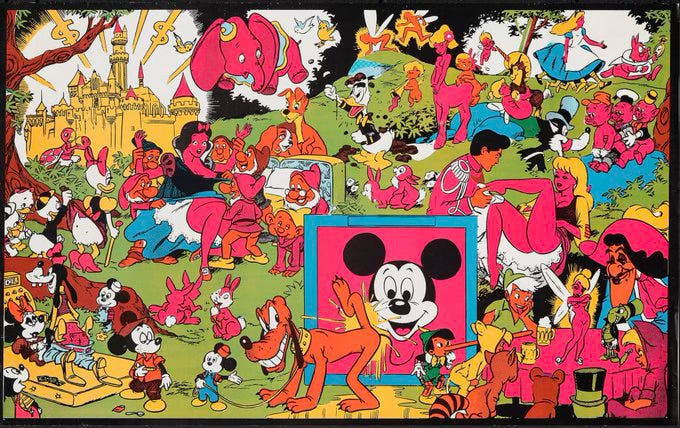The Realist: America’s Most Dangerous Magazine
How Paul Krassner’s Psychedelic Satire, Political Heresy, and Gonzo Hoaxes Redefined the Boundaries of Truth and Madness
The Realist was a groundbreaking American satirical magazine, first launched in 1958 in New York City, and edited and published by Paul Krassner. Known as the magazine of “social‑political‑religious criticism and satire,” its tagline often read variations like social‑political‑religious criticism and satire or unleashed aggression, signaling its irreverent, counter‑culture tone .
What made The Realist stand out
It blurred the lines between journalism and performance art — serious essays and goofy hoaxes lived side by side. Editors and contributors let readers parse which were real and which were gut‑punch satire .
Krassner was famous for pushing boundaries—publishing shock‑value pieces like “The Disneyland Memorial Orgy” poster (illustrated by Wally Wood) and the notorious Kennedy-assassination satire “The Parts That Were Left Out of the Kennedy Book”, which featured grotesque political metaphor so convincing some readers believed it was real .
It gave early platforms to big names: Lenny Bruce, Ken Kesey, Norman Mailer, Joseph Heller, Woody Allen, Robert Crumb, Mae Brussell, and more .
The Realist holds historical significance as an early adopter of conspiracy theory coverage in print and as a proto‑digital voice for counter‑culture discourse before the Internet age .
Timeline & Legacy
1958
First issue published.
1960s
Peak: monthly regularity, national newsstand circulation (~5–7k subscribers).
1970s
Converted to irregular schedule; financial struggles.
1984
Revived as a smaller newsletter format.
Spring 2001
Final printed issue (#146).
Why The Realist still matters
It helped define underground press and satirical activism in mid‑century America.
Its tone fused politics, humor, and conspiracy in a way that resonates with today’s meme‑infused media culture.
It celebrated voice over polish, chaos over consensus—channeling dissent into absurdity.
Here’s a curated list of the wildest, most influential, and culturally radioactive issues and articles from The Realist—the magazine that danced on the graves of taboos and lit fires under the polite skirts of American hypocrisy.
1. “The Parts That Were Left Out of the Kennedy Book” (Issue #55, May 1967)
The most infamous article Krassner ever published.
A grotesque satirical fantasy supposedly “omitted” from William Manchester’s Death of a President. It described Lyndon B. Johnson committing necrophilic acts with JFK’s corpse aboard Air Force One. It was so shocking that people thought it was real. Even Norman Mailer admitted he “threw up” reading it—but added, “It was good enough to be true.”
Result: People began questioning the boundary between journalism and satire—and whether truth was stranger than fiction.
2. The Disneyland Memorial Orgy Poster (1967)
Illustrated by underground comics legend Wally Wood, this full-color centerfold imagined beloved Disney characters in a drug- and sex-fueled bacchanal: Snow White in a compromising position, Goofy shooting heroin, and Mickey Mouse flashing his genitals.
Impact: It went viral before viral was a thing. Disney sued. Collectors still covet the original.
3. Mae Brussell’s Conspiracy Columns (1970s–1980s)
Brussell, one of the first true “conspiracy researchers,” wrote a series of dense, paranoid, and often uncannily prescient columns connecting Watergate, the JFK assassination, the CIA, Nazis, Manson, and more.
Legacy: She laid the groundwork for both left-wing deep-state paranoia and modern QAnon-adjacent thinking (but with better grammar).
4. “Fuck Communism” and Other Button Campaigns (1960s)
Krassner would create bumper stickers and buttons with slogans like “Fuck Communism” (just to test free speech limits), or “Legalize Freedom.” These provocations became part of the counterculture’s fashion, angering conservatives and confusing moderates.
Cultural Detonation: FBI flagged them. Parents banned them. Teens wore them to piss off everyone. I had one on my bedroom wall.
5. “Lenny Bruce Memorial Interview” (Issue #61, Nov 1965)
Krassner conducted a fictional “interview” with the ghost of his friend Lenny Bruce, skewering posthumous sanitization of rebels.
Subtext: Even death doesn’t stop the commodification of revolutionaries.
6. Norman Mailer’s Essay: “A New Spiritual Politics” (Issue #89, 1971)
Yes, Mailer in The Realist. In a more cerebral but still spicy entry, he argued that political engagement without mysticism is dead on arrival. Not satire, but provocatively placed.
Takeaway: Even serious thinkers wanted in on the chaos Krassner was cultivating.
7. “Joe Stalin: Sex Maniac” (Issue #60)
An over-the-top parody of Red Scare hysteria, this feature detailed “evidence” of Stalin’s degenerate bedroom exploits, complete with fake footnotes.
Krassner’s M.O.: Make the absurd so extreme it reveals deeper truth about American propaganda.
8. “My Trip with the CIA” – Paul Krassner’s Acid Test (Various Issues, mid-1960s)
Krassner detailed his own LSD trips, interviews with Timothy Leary, and encounters with CIA agents experimenting with psychedelics.
Psychedelic Satire meets Spycraft: Government paranoia and acid evangelism, filtered through a laughing mirror.
9. The Unexpurgated Confessions of Ralph Ginzburg (Issue #102, 1984)
After being jailed for “obscenity” over Eros Magazine, Ginzburg unloaded his story in The Realist.
Power & Censorship: Ginzburg’s fall showed what happens when publishing crosses too many lines too fast.
10. “Confessions of a CIA Hitman” (Issue #107, 1990s reprint)
An anonymous letter from a supposed contract killer claiming to have eliminated targets for the U.S. government.
Fact or fiction? No one knew—and that was the point.
All 146 issues are archived here, scanned and searchable:
The Realist was like if MAD Magazine dropped acid, read Foucault, then crashed a Senate hearing naked with a bullhorn. It didn’t just predict the culture war—it helped ignite it. And in its gonzo, fearless way, it asked the most dangerous question of all: what really is the truth.
+ + + + + +
Until we meet again, let your conscience be your guide.








The Realist introduced me to Lenny Bruce when I was 9 years old. I'll be 75 in a couple of weeks.
Love PK and The Realist. He had a long run in LA doing a late night set that included watching the news at 11 with his simultaneous commentary. BIG fun.